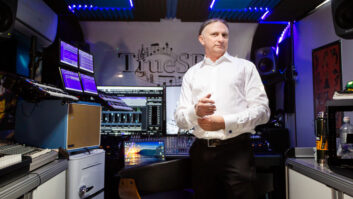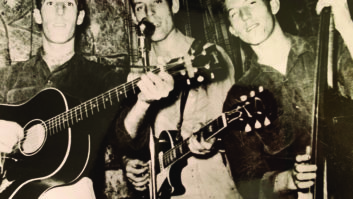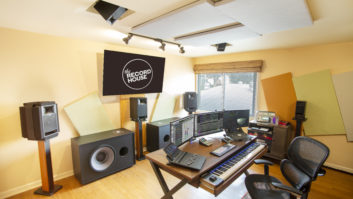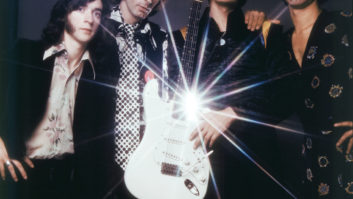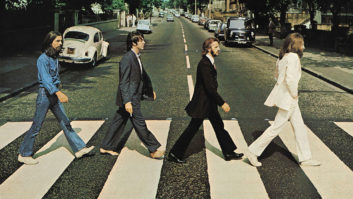Every genre of music has its titans—that small circle of acts who hit the zeniths of both artistry and popularity. Music fans spend countless hours arguing who the top classic rock acts are or debating about the greatest rappers of all time. When it comes to Thrash Metal though, there’s very little disagreement among the devoted—so little, in fact, that the best of the best are simply referred to as The Big 4: Metallica, Slayer, Megadeth and Anthrax.
Metallica soundchecks at Yankee Stadium
with singer James Hetfield crooning into
a Shure 55 while groundskeepers lay
sheeting to protect the outfield.The bands have each been around since the 1980s and have played together from time to time, but getting all four on the same bill never happened until June 2010 in Sofia, Bulgaria, at the Sonisphere Festival. Since then, the bands have played a few more Big 4 one-offs, and the whole riotous concoction most recently crash-landed into New York City’s Yankee Stadium in September.

Metallica’s longtime sound vendor, Thunder Audio (Livonia, MI), provided gear and a dozen men for the massive production, which only had two days for load-in, given the constraints of the baseball season. The event’s massive stage and general admission audience stood in the outfield, with the FOH mix position situated right beyond second base.
Covering the expanse of the stadium were 124 Meyer Sound Milo line-array boxes bolstered by 88 700-HP subwoofers. “It’s nearly as many boxes as we use for Metallica in the round, but that’s always done for distribution, not for volume,” said Thunder’s Paul Owen, no stranger to the band’s production needs, having been its monitor engineer for years before moving behind Thunder’s vice president desk.
Filling Yankee Stadium with sound, however, required volume and careful zoning. “There’s very high seating,” Owen noted. “We sold pretty well all the way around. Seating cut off in the upper bowls at 180 degrees, but you really have to play up to that 180—you wouldn’t reach it with just a forward-facing PA. We kept the main hangs as long as we could, so they were up to 22, and also had a center hang of Meyer Micas firing down into the pit; that helped us flatten the system out without having to curve it down all the way to the front row. Then the side hangs, given that large, wraparound seating, had to elevate up yet also cover down to the people as well. On a flat field, normally you’d get away with those sidehangs being 8-9 deep, but we ended up having to make them 12-14 deep just to get the elevation.”
Thunder Audio VP Paul
Owen shows off some
of the 124 Meyer Sound
Milo line-array boxes and
88 700-HP subwoofers.Complicating the production, however, was the fact that nothing could go on the infield—no towers, no delays, not even Metallica’s FOH engineer of the last 28 years, Big Mick Hughes: “I was trying to tune the PA and wanted to walk across the system from side to side to listen to how it propagated around. I took a few steps and they went berserk, screaming ‘Get off the grass!’ That grass is cared for more than most people.”

To keep the infield clear, delay hangs of a dozen Milos each had to be placed in less than ideal positions, with two hangs at home plate, and single hangs at roughly first and third bases. “We couldn’t get the delays in alignment with the main system,” said Big Mick. “They were going to be firing across the main system slightly, which means the time would be ever-changing, so we kept the main system focused down on to the floor, put the delays higher, and never let the two overlap too much, because the interference pattern would’ve been vicious. By keeping everything zoned a bit, I think we kept it a little bit cleaner.”
Having the house mix position out in centerfield resulted in some anomalies when it came time to mix. “All in all, it wasn’t a bad-sounding stadium,” said Owen. “When the wind kicks up 5-10 mph, it acts like a bit of vortex—it spins around and all of a sudden the high-end of the PA goes away and comes back again. You do find that somewhat in a bowl as opposed to a square stadium. There were also a lot of reflections, especially during soundcheck with the delays on. With no people in the seats and no absorption, the amount of reflection and clatter going on was quite considerable.”
Those reflections, however, led to more a worrisome concern, he explained: “When you put the mix position 150 feet in front of the seats behind home plate, and you’re in front of the downstage subs, it creates a complete cancellation of the bass—it goes completely out of phase.”
Big Mick elaborated, “There’s a reflection that comes off the side of the stadium and cancels out a considerable amount of the 50-60 Hz at FOH. We looked at the SIM 3 machine and it showed the coherence was horrible. But I’ve heard that before, where you struggle with the low end in the day before the show, and it just had the same air about it. I said to the guys, ‘We can mess around as much as we want to try making more low-end, but I’ve got a feeling that we’ve got more than enough; it’s just not showing itself right now.’ So we waited, and the next day, people came in, the reflection went away and we got a lot of that frequency back. I had to turn the subs down, in fact.”
While the bass frequencies may have been problematic at the FOH position, the gear there was not. A variety of Midas consoles were on hand, all supplied by Thunder Audio, such as an XL8 for Metallica, a Heritage 3000 for Anthrax and a Pro6 for Megadeth. For the monitor mix positions at stageside, Metallica monitor engineers Bob Cowan and Adam Correia had a Midas XL4, while the other acts mixed on Yamaha PM5Ds.
Hughes, an XL8 user since before it was officially released, oversees roughly 80 channels including effect returns. “We used to make Metallica fit on the XL4, with all stereo channels and using the line returns— we’d put anything in any hole we had on that. When someone like Lemmy from Motorhead showed up and he was gonna play, I’d be thinking ‘I’ve got no channels! Where will I shove him in? Do we really need a hi-hat tonight?’ Now I can go ‘Pick a channel and I’ll grab it up the splitter; just tell me what number it is.’ MTV shows up, asks for a split, it’s ‘Plug into that I/O box there’ and you patch it to the holes. Whenever someone asks you for stuff, now you can always say, ‘Yes.’”
Of course, part of any FOH engineer’s job is ensuring that he can say ‘yes’ to the band, too, like making a favorite microphone that’s not necessarily best suited for the Metallica concert environment work anyway. “We have some Shure 55 vocal mics that we use,” said Big Mick. “James [Hetfield, singer] really likes the way they look and I understand that—I think they look fantastic, too—so I sort it out with a substantial amount of EQ and compression.”
Elsewhere on stage, the drum kit is surrounded predominantly by Audio-Technica mics, such as ATM350s on overheads and toms, while the kick is captured via an Audix D6 and a Shure SM91a, and the snare is heard via a combination of Earthworks and Audio-Technica mics. The crucial guitar sounds are grabbed via Audio-Technica AE2500 dual-element mics, while Countryman and Radial DIs entwine with bassist Robert Trujillo’s wireless system and bass amp respectively to create the bass sound.
After seven hours of the Big 4, even the hardiest headbanger would be forgiven for feeling exhausted. Even so, one of the evening’s last songs found all four groups assembling on stage for a rave-up through Motorhead’s “Overkill.” Even at that highpoint, however, the volume never drew the ire of the authorities— not that it mattered, apparently.
“Nobody said a word to me the whole time; never even saw someone measuring it,” said Big Mick, with a pause. “To be honest with you, I was kind of surprised. Then again, I’m sure we were no louder than a stadium of fans roaring at a game!”
Thunder Audio
Meyer Sound Labs
Midas

